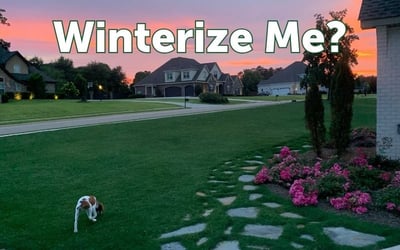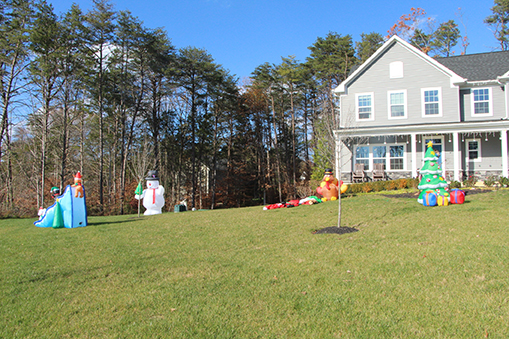

Lawn Care for Inflatables and Fireworks During Winter Holidays


This time of year, most people are not thinking about how their lawns respond to outdoor activities, but there are still a few things to consider.
While you read, keep in mind if you have a cool season or a warm season lawn. Cool season lawns (such as Tall Fescue) are actively growing during the cool months of fall, winter, and early spring; while warm season lawns (such as Bermuda, Centipede, and Zoysia) are dormant or in the process of going dormant during the same cool months.
The following tips will help you prevent and repair lawn damage from wintertime fun on any kind of grass.
Inflatable Decorations & Lawns
From Halloween through New Year's Day, there are non-stop occasions for inflatable witches, turkeys, Santas, or snowmen on your lawn, festively placed to delight the neighborhood. Yet, did you know all the cheer could cause issues for your lawn if you're not proactive?
Nina Johnson, marketing manager, snapped this picture as she waited for trick or treaters.
Cool Season Lawns & Inflatables
Since cool season grasses are actively growing, smothering areas of the lawn with plastic Santa feet is a real possibility. If you're putting inflatable decorations on your Tall Fescue lawn, move the footprint around slightly every day or consider putting them on your mulched beds. Even though it's cold out, they can still smother your lawn if left on it too long.
If you planted Tall Fescue seed this fall and have young, tender seedlings, then you'll definitely want to keep inflatables off them.
Dormant Warm Season Lawns & Inflatables
For warm season lawns, smothering is much less of an issue this time of year. If it's unseasonably warm and your lawn is still partially green, consider moving your ghouls and elves around every few days.
Feeling festive? If you have a Fescue lawn, keep your inflatable holiday displays in your mulched beds and off your grass.

New Year's Fireworks & Lawns
Before you light any fuses, think about where you've placed your fireworks. My first choice would be to light them on a non-flammable surface such as a driveway. Yes, I'd rather my driveway suffer burn marks than my prized Zoysia lawn.
Witnessing this flare up at a friend's party reinforced my paranoia about fireworks on grass. Thankfully the guys had a water hose handy and quickly put it out.

Cool Season Lawns & Fireworks
During these cool months, Tall Fescue lawns thrive and are full of water and life. That makes them less susceptible to sparks starting a grass fire than with dormant warm season lawns. However, burn damage to your Tall Fescue is still something to keep in the back of your mind as you consider where to stage your display. Scorch marks on your green Fescue lawn will be instantly apparent.
If you lay down a piece of plywood on top of your Tall Fescue lawn to protect it from fireworks, remember to pick it up the next morning. Any item left laying on your grass for too long, especially if we have a warm spell, will cause your Tall Fescue to turn yellow or worse.
Dormant Warm Season Lawns & Fireworks
The risk of firework damage or grass fire is higher when a warm season lawn is dormant in the fall and winter than when it is actively growing. The reason is because the water has left the leaves - the brown material that remains is dry and can be ignited by sparks. If it hasn't rained for a few weeks, the risk is even higher.
Keep a hose handy and minimize firework sparks from contacting your lawn. Consider tactics to protect your lawn, such as moving the show to the neighbor's lawn (I'm joking - move it to the driveway).
Lawns are Fixable
If your lawn gets hurt in all the holiday fun it can be fixed! Here are repair solutions:
Water
- When your warm season lawn starts growing again in the spring, water the heck out of it.
- Extra water will help stolons from the surrounding healthy grass regrow into the bare area.
Watch & Wait
- Warm season lawns will grow back via the runners (called stolons) when it starts actively growing again - water them to help the process (see point above).
- If your cool season lawn didn't completely die out, but only turned an off-color yellow, then it should green up again within a few weeks. If the waiting is getting to you, nitrogen fertilizer will help cool seasons lawns green up.
Aerate & Compost Topdress
- You'll need to wait until your warm season lawn greens up in spring to aerate and topdress with compost. This technique will revive the entire lawn because the compost will add natural nutrients that benefit the whole network of roots and runners.
- Cool season lawns can be aerated and compost-topdressed up until the seasons change and it starts to warm up in the spring. Usually April is the last chance to safely aerate Tall Fescue lawns; in warmer regions that would be late March or early April.
- Read all about How to Aerate Your Lawn.
- Read our Soil³ blog for more info on topdressing.
Reseed
- Zenith Zoysia and TifBlair Centipede can be patched with seed during summer.
- Elite Tall Fescue seed can be replanted during fall.
Resod
- Come get a few rolls! You can order online and pick up at your local Super-Sod.
- Here's how to patch small areas with a few rolls of sod.
Most damage from having fun on your lawn does happen during summertime use of inflatables, fireworks, and tents.
Even so, don't forget about your lawn's health when it comes to holiday decor and festivities this winter. If it's too late and the damage is done, take heart because it can be fixed and repaired. Give us a shout if you have any questions!
Winter Lawn Maintenance
Read the rest of our seasonal lawn maintenance tips, by grass type for every month.





